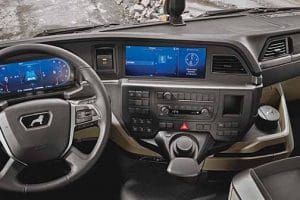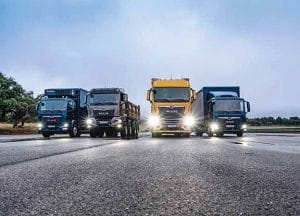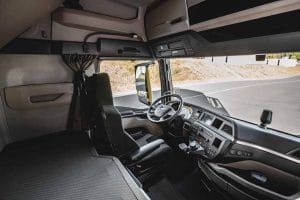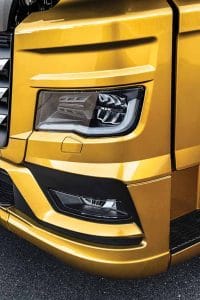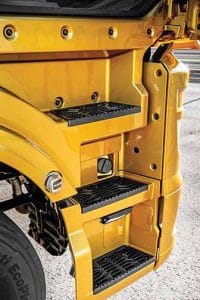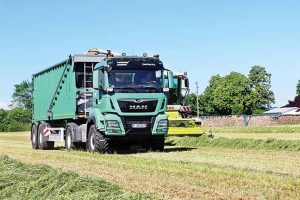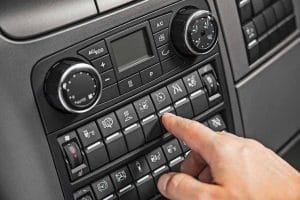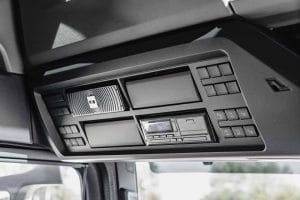The new MAN truck generation elevates driver orientation and environment protection to a new level.
Team CV
Unveiled at Bilbao in Northern Spain in February 2020, the new MAN truck generation marks a significant change in the orientation of one of the oldest and best-regarded German CV manufacturer that MAN is. Representing a journey from a vehicle manufacturer to a provider of intelligent and sustainable transport solutions, the new MAN truck generation, following in the footsteps of legendary series, dials new level of comfort, safety, efficiency, reliability, service as well as connectivity and digitalisation. Making customers’ business easier, more efficient and thereby more successful, according to Joachim Drees, Chairman of the Executive Board at MAN Truck & Bus SE, the new MAN truck generation includes the TGL, TGM, TGS and TGX model series from 7.5- to 41-tonnes. Encompassing eight new cabs in the process, the new truck generation provides a suitable concept for resting and the sleep area by looking beyond the requirements of high fuel efficiency and ergonomic operating logic for relaxed and fatigue-free driving.
Adding a new dimension to the premise of long-haul transport or operation of a truck at a construction site against the background of driver shortage and some unprecedented challenges, the new MAN truck generation, enabling drivers to regenerate optimally during breaks by complete rest, takes into consideration the changing form of road freight (transport) as part of a nation’s or continent’s economy. For example, considering the transport volume in the European Union to increase by an additional 40 per cent in the next 20 years, the new truck generation has been developed with strict legal regulations, which intend to reduce CO2 emissions by 15 per cent by 2025 (with an additional reduction by 30 per cent by 2030) in Europe, in consideration. Providing the driver an ability to retain concentration and steer his or her truck through traffic in a safe and environmentally friendly way, the new MAN truck generation unites tried-and-true virtues with future-oriented developments.
Reliable and efficient
Keen to take the burden off freight forwarders and drivers and making their daily work easier despite increasingly complex framework conditions, the new truck generation underlines assistance systems like semi-automated driving in traffic jams and turn assist. Emphasising on reliable usage, the new MAN truck generation strives to provide good visibility and optimum display of important driving information in urban driving situations and at construction sites where tricky manoeuvres are the order of the day. It looks at ergonomics like frequent cab entry and exit as part of the daily work routine in areas like urban distribution transport or municipal services. Underlining the need to choose the right body for the transport task at hand, and a chassis that offers optimum technical and electronic interfaces, whether it is a three-way tipper, a roll-off skip loader, a refrigerated body, a refuse collector vehicle or a timber transporter, the new truck generation is about appropriate driveline design; about modular form, and unity in diversity.
The three large capacity cabs — GX, GM and GN – out of the eight new cabs for example, make a perfect choice for long-haul international transports. They provide plenty of luggage and storage space, and incorporate features like headlights with integrated daytime running lights and indicators, and LED side indicators. Supporting outstanding freedom of movement, an airy interior ambience and supreme levels of comfort, the eight cabs of the new truck generation are not just striking in their appearance, they also point at how MAN has looked at the finer details. An instrument panel that is driver oriented for example. The vario passenger seat that can be turned inwards, and a large lower rotating ring called the ‘SmartSelect’ that helps the driver to navigate through the main menu for example. Powered by the Euro6d engine range, which includes the (400 to 520 hp) 12.4-litre D26 unit, (279 to 440 hp) 9.0-litre D15 unit, and the (540 to 640 hp) 15.2-litre D38 unit, the new MAN truck generation boasts of a newly developed consumption-reducing driveline and software components that contribute to additional fuel savings of up to eight-per cent.
Smart and flexible
If the improved aerodynamics of the new striking-looking cab design also contributes toward lower fuel consumption, the new MAN truck generation features innovative tech such as EfficientCruise. It uses telematics to further advance the tracing and tracking function to a level where the onboard computer memorises road or route topography and adds it to the road map data. By doing so, it also calculates the optimum speed and gear switching strategy to provide real-time driver coaching in the interest of fuel efficiency. A part of this is also a new found ability of the new generation truck to switch automatically between acceleration and rolling on flat terrain. Involving comprehensive product improvements for components, and in the areas of maintenance and service to reduce service life costs, the new MAN truck generation also offers significant payload advantages for weight-sensitive application sectors.
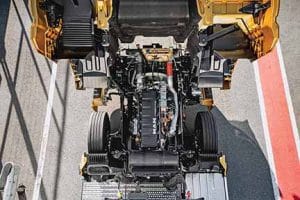 Engineered to guarantee the best uptime, reliability and safety, the refreshing of key aggregates like body, running gear, lighting system, braking system, driveline and visibility related components make the new generation truck stand out. To further enhance its reliability and safety, it has been equipped with a new, simplified, powerful and future-proof electronics architecture. It is designed to significantly improve and expand the functionalities of the trucks. If the digitalised maintenance management system reduces operating costs and ensures maximum uptime, fleet management and drivers are supported through numerous digital functionalities and services. A highly user oriented new consultation and offer system ensures that each and every truck made under the TGX, TGS, TGM and TGL model-lineup fits the exact transport task it is intended to carry out.
Engineered to guarantee the best uptime, reliability and safety, the refreshing of key aggregates like body, running gear, lighting system, braking system, driveline and visibility related components make the new generation truck stand out. To further enhance its reliability and safety, it has been equipped with a new, simplified, powerful and future-proof electronics architecture. It is designed to significantly improve and expand the functionalities of the trucks. If the digitalised maintenance management system reduces operating costs and ensures maximum uptime, fleet management and drivers are supported through numerous digital functionalities and services. A highly user oriented new consultation and offer system ensures that each and every truck made under the TGX, TGS, TGM and TGL model-lineup fits the exact transport task it is intended to carry out.
Supported by a product logic that is consistently oriented towards the application profile, the new MAN truck generation offers comprehensively adjustable and flexible configuration options and individually coordinated services. Turning it into a holistic, integrated transport solution thus, the new truck generation saw over 700 drivers look at the prototype solutions (involving visits to truck stops and service stations) during its development phases. Much professional feedback has also obtained. With comprehensive improvements carried out to production and sales, MAN invested around Euro 100 million euros. A big chunk of it went into the Munich site where up to 500 cabs from the new generation truck range would be produced per day. Another Euro 85 million went into the construction of new cab paint shop to meet the increased output of cab construction.
Most ambitious MAN project yet
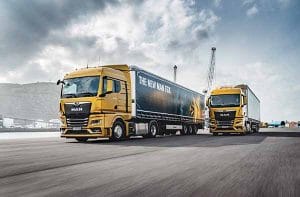 An advanced paint shop was also built at MAN’s Steyr, Austria, facility. It builds the TGL and TGM series. Changes at the Steyr plant were also carried out to ensure that all plastic attachment parts for the entire MAN production network will be exclusively processed there in the future. Marking among the most ambitious projects ever in the span of 20 years by the German CV major, the new truck generation saw 12,000,000 working hours being spent as a project involving 2100 employees directly. Some 167,000 working hours were spent on new vehicle design and 4,000,000 km worth of testing was carried out until market launch. Apart from 2,800,000 lines of software code development, the new truck generation saw MAN integrate around 22,000 new item numbers into all departments. Available with 3,000 cab colours as standard, the new truck generation is backed by a central thought process that the individual transport task of the customer is at the forefront.
An advanced paint shop was also built at MAN’s Steyr, Austria, facility. It builds the TGL and TGM series. Changes at the Steyr plant were also carried out to ensure that all plastic attachment parts for the entire MAN production network will be exclusively processed there in the future. Marking among the most ambitious projects ever in the span of 20 years by the German CV major, the new truck generation saw 12,000,000 working hours being spent as a project involving 2100 employees directly. Some 167,000 working hours were spent on new vehicle design and 4,000,000 km worth of testing was carried out until market launch. Apart from 2,800,000 lines of software code development, the new truck generation saw MAN integrate around 22,000 new item numbers into all departments. Available with 3,000 cab colours as standard, the new truck generation is backed by a central thought process that the individual transport task of the customer is at the forefront.
New electronics architecture
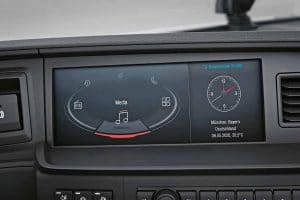 The slimmed-down, application-oriented design of the new electronics architecture on every new MAN truck generation vehicle involves a main cable harness designed in a customer-specific manner such that it addresses specific equipment and application needs. Calling for fewer plug connectors, and making it possible to reduce weight, the new electronics architecture also reduces assembly efforts and lowers maintenance. If certain types of damage occur, it makes it possible to disconnect the cable harness at certain points and repair it in a targeted manner, preventing the need for a complete replacement of components. In addition to the previous interfaces for body manufacturers under the front panel, there is now an additional interface on the frame behind the cab to ensure power supply to the body.
The slimmed-down, application-oriented design of the new electronics architecture on every new MAN truck generation vehicle involves a main cable harness designed in a customer-specific manner such that it addresses specific equipment and application needs. Calling for fewer plug connectors, and making it possible to reduce weight, the new electronics architecture also reduces assembly efforts and lowers maintenance. If certain types of damage occur, it makes it possible to disconnect the cable harness at certain points and repair it in a targeted manner, preventing the need for a complete replacement of components. In addition to the previous interfaces for body manufacturers under the front panel, there is now an additional interface on the frame behind the cab to ensure power supply to the body.
The control signals run via a CAN bus connection and the electronic hardware required for the body can thus be connected inside or outside the cab as required. Featuring a modern, central computer which controls all processes, the system enables significantly improved interaction between all sensors installed. While the pre-existing assistance systems now work even more effectively and complement each other perfectly, the new vehicle electrical system provides the foundation for future applications such as automated driving. It also simplifies the process of retrofitting various functions which are now newly available, such as the turn assist system.
Semi-automated driving and turn assist
With the driver at the centre, the new MAN truck generation integrates a suite of advanced features to create the basis for semi-automated driving. These include the TipMatic automated transmission that is operated via a stalk on the steering column. The stalk also features the operation of continuous brake. Next to the main display on the instrument panel is the electronic parking brake, which under certain conditions when parking or leaving the parking area, engages and disengages automatically. While the central truck display acts as the nerve centre of driver assistance systems, the new MAN truck generation includes Lane Change Support (LCS) that uses radar sensors, active steering system and the onboard computer to monitor the areas of the left and right of the truck at speeds of 50 kmph or more; Lane Return Assist (LRA) that reliably keeps the truck in its lane at all times by using the radar sensors, active steering system and onboard computer, and ACC Stop & Go that reliably maintains the correct safe distance even at speeds as low as one-kmph and up to 15 kmph. If the truck in front stops for less than two seconds and moves, the system automatically gets the truck going. If the truck in front stops for more than two seconds, stepping on the accelerator gets the truck going again.
As part of the semi-automated driving tech, the new MAN truck generation also features Congestion Assistant (CA) that works as an extension of ACC Stop & Go, and is activated at speeds of between 40 kmph and 60 kmph. It decelerates the vehicle by gauging the behavior of the vehicle in front using the driveline, brakes and steering independently. The Emergency Brake Assist (EBA) intervenes when there is a risk of a rear-end collision by initially warning the driver during critical situations and initiating emergency braking if he or she fails to act.
 The MAN AttentionGuard uses lane monitoring data evaluates the number of times the vehicle strays from the lane as well as the steering interventions to gauge driver’s alertness and issues an optical warning in the display. The High beam assist automatically controls the use of high beam as per the driving condition. Configured into curtains that slide from left to right, the central truck display relays a plethora of information regarding the vehicle health, driving manner, driving times, radio, telephone, etc. Also connected to it are the navigation functionalities and the infotainment functionalities.
The MAN AttentionGuard uses lane monitoring data evaluates the number of times the vehicle strays from the lane as well as the steering interventions to gauge driver’s alertness and issues an optical warning in the display. The High beam assist automatically controls the use of high beam as per the driving condition. Configured into curtains that slide from left to right, the central truck display relays a plethora of information regarding the vehicle health, driving manner, driving times, radio, telephone, etc. Also connected to it are the navigation functionalities and the infotainment functionalities.
The MAN media system includes a driver card, which saves driver configuration and activates it once the driver inserts the card into the tachograph. The turn assist system uses the radar sensors to monitor the hard-to-see side areas next to the vehicle (especially on the co-driver’s side) at driving speeds of up to 30 kmph. A three-part LED strip in the A-pillar warns the driver in critical situations using levels. The warning level depends on how far the other detected road user is from the vehicle and whether there is a risk of an accident from the pre-calculation of the paths. If the system detects a critical situation arising, all three LED modules will flash and a warning signal will also sound. This enables the driver to intervene in good time to mitigate the situation. 